Here’s an awesome idea: if you want more shelving in your small space, if you want to ‘hide’ a private room, or if you just want to have an awesome door you can talk about with guests. Turn a door into a set of shelves! (Or should that read: Turn some shelves into a door! :) )

This is also a great DIY project for bringing life to a part of your house rarely visited. For instance, if your storage room is located at the end of the hallway, you can give that door an additional purpose by using it as decorative shelving as well. Install wireless LED bookcase lighting and you’ve just made that dull area into a brighter, happier place!
Contents
Turning a Door Into Shelves
Materials
- Solid Core Door (2040 x 820 x 35mm)
- 2 Pine Shelving Unit Sides (84 x 19 x 1725mm)
- 7 Pine Shelving Unit Shelves (184 x 19 x 480mm)
- 6 Pine Lip Beading (12 x 12 x 480mm)
- 2 Pine Quad Vertical Beading (12 x 12 x 1749mm)
- 2 Pine Quad Horizontal Beading (12 x 12 x 542mm)
- 2 Pine Cleats (70 x 19 x 560mm)
- 2 Pine Quad Back Beading (12 x 12 x 1725mm)
- White Melamine MDF Shelving Unit Back (1725 x 518 x 3mm)
- 4 Chrome Broad Butt Hinges (100mm)
- Assorted Nails and Screws
- Wood Filler
- Primer
- Sealer and Undercoat
- Acrylic Low Sheen
- Magnetic Catch
Tools
- Clamps
- Measuring Tape
- Combination Square
- Pencil Marker
- Circular Saw
- Chisel
- Hammer
- Cordless Drill
Instructions
Preparation
- Gather Materials and Tools: Ensure all listed materials and tools are on hand before starting the project to streamline the process.
- Safety First: Wear appropriate safety gear, including safety glasses and gloves, throughout the project.
Construction Steps
- Measure and Mark: Using the measuring tape and pencil marker, carefully measure and mark where you will cut the door for the shelving unit sides and where the shelves will be attached. Use the combination square to ensure all lines are straight and angles are accurate.
- Cut the Door: Using the circular saw, cut the solid core door according to the marked measurements to create the frame for your shelving unit. This will involve cutting the door to the desired height of the shelving unit if necessary.
- Prepare Shelving Sides and Shelves: Cut the two pine shelving unit sides and the seven pine shelves to the required lengths if they are not already at the desired dimensions.
- Attach the Sides: Position the pine shelving unit sides along the vertical edges of the cut door. Secure them in place using the cordless drill and screws. Ensure they are perfectly vertical using the combination square.
- Install Shelves: Measure and mark the positions for the shelves on the shelving unit sides. Drill pilot holes and then attach the shelves using screws. Ensure the shelves are level before securing them.
- Add Beading for Support and Aesthetics: Attach the pine lip beading along the front edge of each shelf using nails and a hammer for added support and a finished look. Similarly, affix the pine quad vertical and horizontal beading to the edges of the shelving unit for additional stability and decorative detail.
- Install the Back Panel: Place the white melamine MDF panel against the back of the shelving unit. Secure it in place with nails or screws, ensuring it’s flush and aligned with the edges of the shelving unit.
- Mount Hinges: Attach the chrome broad butt hinges to the side of the shelving unit that will serve as the “door” side, using the screws and cordless drill. Ensure they are evenly spaced and aligned correctly
For a Smooth Operation
- Sanding and Finishing: Use a sanding block or an electric sander to smooth all surfaces, edges, and corners. Pay special attention to the areas around the beading and shelves to remove any splinters or rough patches.
- Apply Wood Filler: Fill any gaps, screw holes, or imperfections with wood filler. Once dry, sand these areas again to ensure a smooth, even finish.
- Priming and Painting: Apply a coat of primer to the entire shelving unit, followed by sealer and undercoat as needed. Once the primer is dry, apply the acrylic low sheen paint in your chosen color. Let each coat dry thoroughly before applying the next one.
- Attach Magnetic Catch: Install the magnetic catch on the inside of the shelving unit door and the corresponding piece on the shelving unit frame. This will help keep the door closed and secure when not in use.
- Final Installation: If the shelving unit is not yet positioned in its final location, move it into place. Use the clamps to hold the unit securely if attaching it to a wall or another fixed structure. Drill pilot holes and use screws to secure the shelving unit in place, ensuring it is stable and level.
Final Checks and Adjustments
- Inspect the Unit: Open and close the door several times to check for smooth operation. Adjust the hinges if necessary.
- Load the Shelves: Start placing items on the shelves, distributing the weight evenly. Avoid overloading to ensure the stability and integrity of the shelving unit.
Safety and Stability Considerations
Transforming a door into shelves is an innovative way to repurpose existing materials and add functional storage space to your home. While this project offers creative and practical benefits, it’s essential to prioritize safety and stability throughout the process. Ensuring your door-into-shelves unit is secure and safe for use is paramount to prevent accidents and maintain the integrity of your creation.
Here, we delve into the key safety and stability considerations when undertaking a door into shelves project.
Secure Mounting
One of the critical aspects of converting a door into shelves is ensuring the entire unit is securely mounted to the wall or floor, depending on the design. Proper anchoring is crucial to prevent the shelving from tipping over or collapsing, which could lead to injuries or damage to items on display.
Use appropriate mounting hardware suitable for the wall material, whether it be drywall, plaster, or masonry. Finding the studs behind the wall for a more secure attachment is sometimes necessary, especially for a heavy door-into-shelves unit.
Shelf Load Capacity
Understanding and respecting the load capacity of each shelf within your door into shelves is vital. Overloading shelves can cause them to sag, weaken, or even break, posing a risk to safety and the unit’s longevity.
When planning your door into shelves project, consider the weight of the items you intend to store or display and ensure the materials used for the shelves, including the door itself, can support this weight. It may be helpful to reinforce shelves with additional brackets or supports if heavy items will be placed on them.
Stable Design
The overall design of your door into shelves should prioritize stability. This includes considering the height-to-width ratio to prevent the unit from being top-heavy and prone to tipping. Lower, wider units tend to be more stable, but securing the unit to the wall at multiple points can enhance stability if a taller design is preferred or necessary. Also, consider placing heavier items on lower shelves to lower the center of gravity of the door-into-shelves unit.
Regular Inspection and Maintenance
After completing your door into shelves, regular inspections and maintenance are key to ensuring its continued safety and stability. Check for any signs of wear and tear, such as loose screws, weakened joints, or damage to the shelves or backing. Periodic tightening of hardware and repairs to any damage can prevent accidents and extend the life of your door into shelves.
Child and Pet Safety
If children or pets are present in your home, additional safety measures should be taken with your door into shelves. This includes anchoring the unit to the wall to prevent it from being pulled over, using safety locks or catches to secure the door if it’s still operational, and avoiding placing tempting items or dangerous tools within easy reach of children.
By adhering to these safety and stability considerations, your door into shelves project will be not only a visually appealing addition to your home but also a safe and durable one. Ensuring the proper steps to secure and maintain your unit will provide peace of mind and all
Click on any image to start lightbox display. Use your Esc key to close the lightbox.

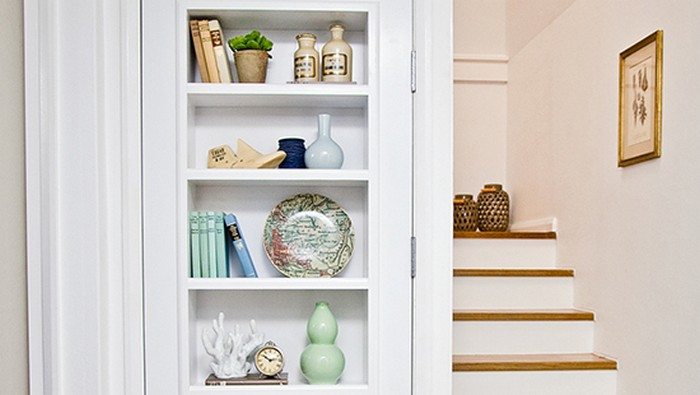
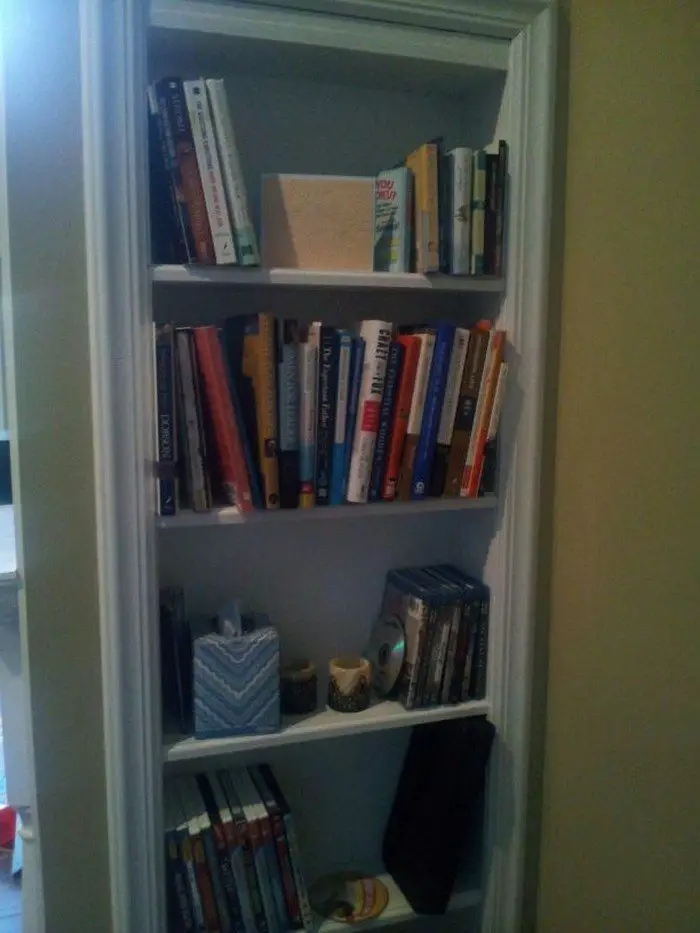
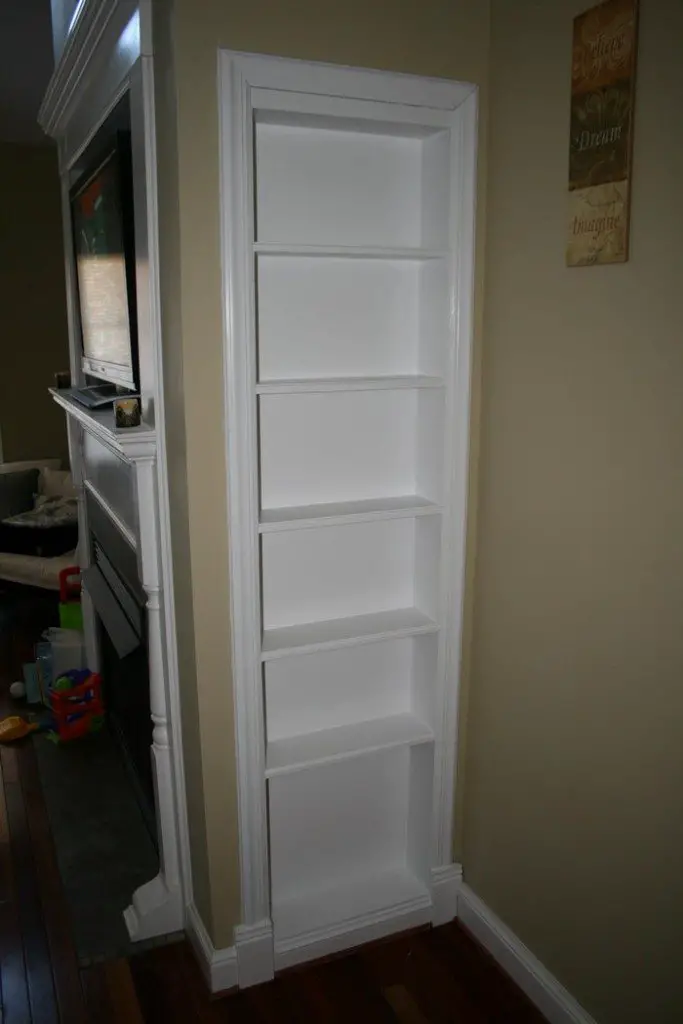
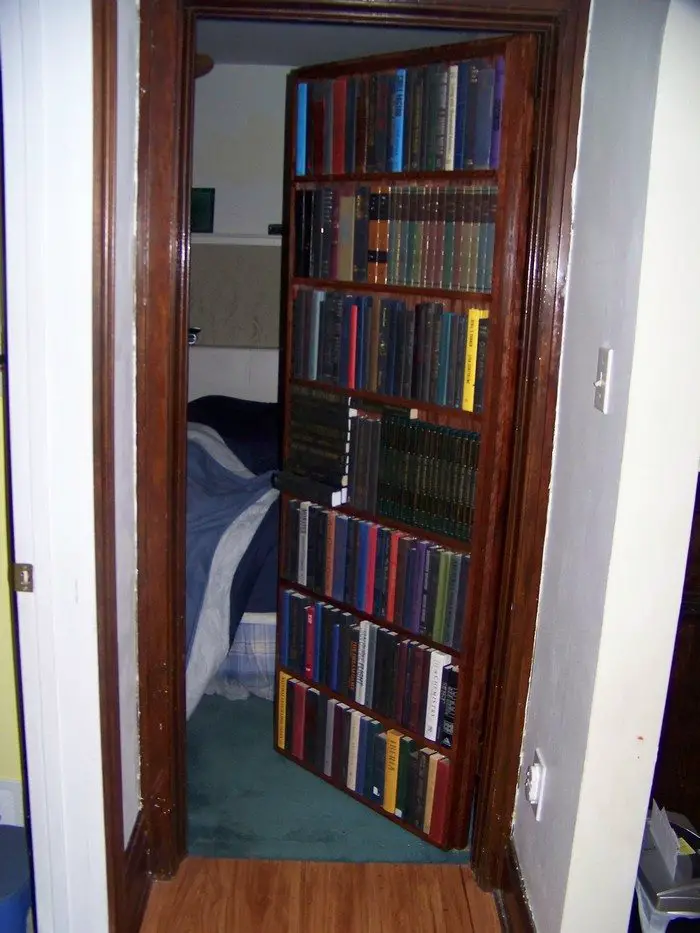
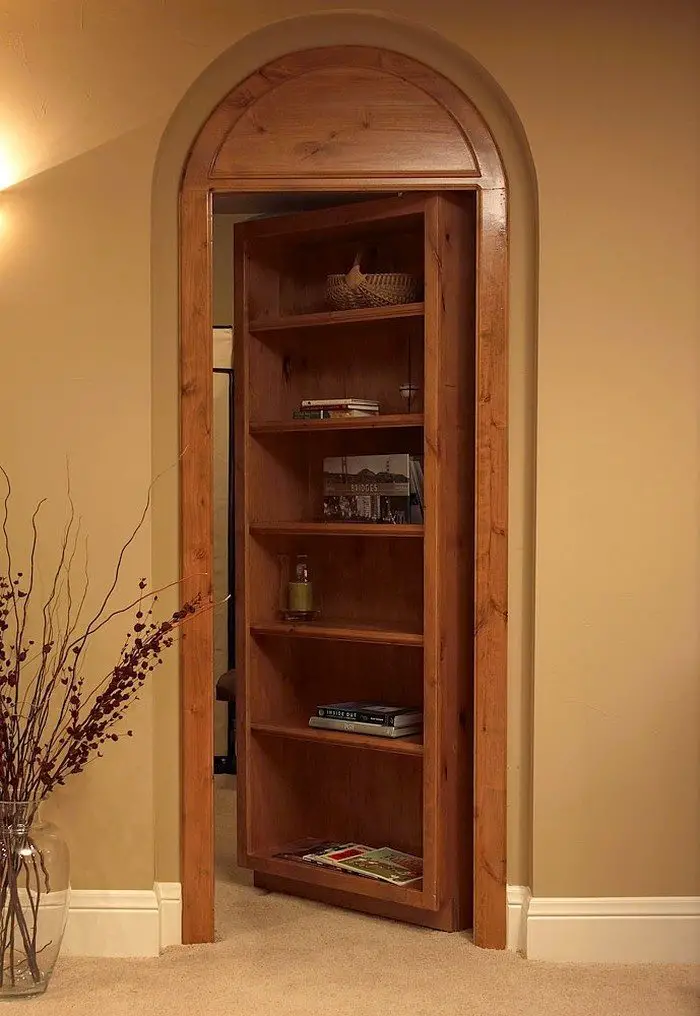

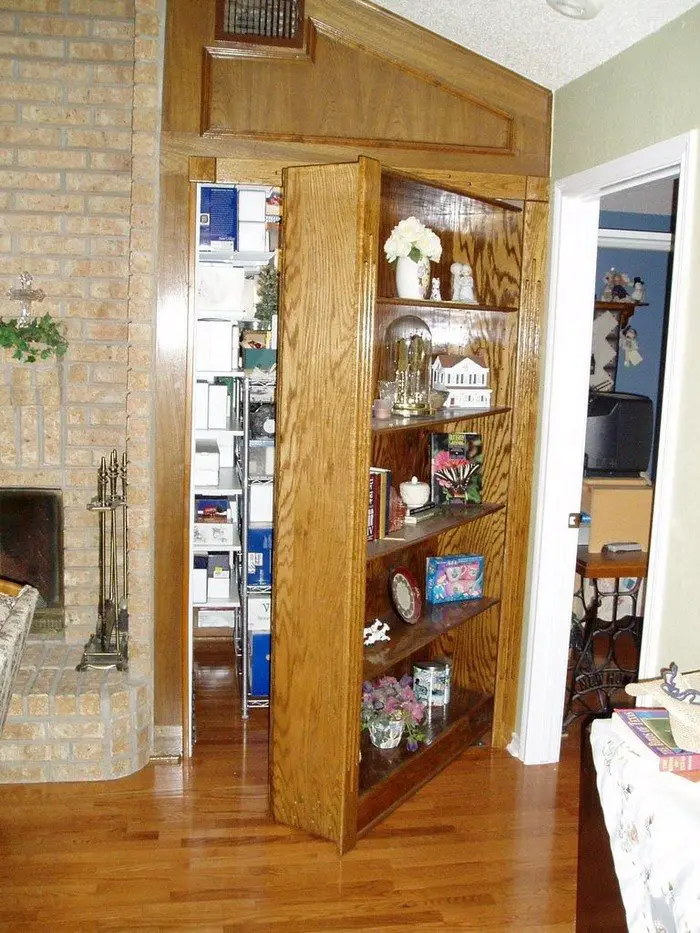

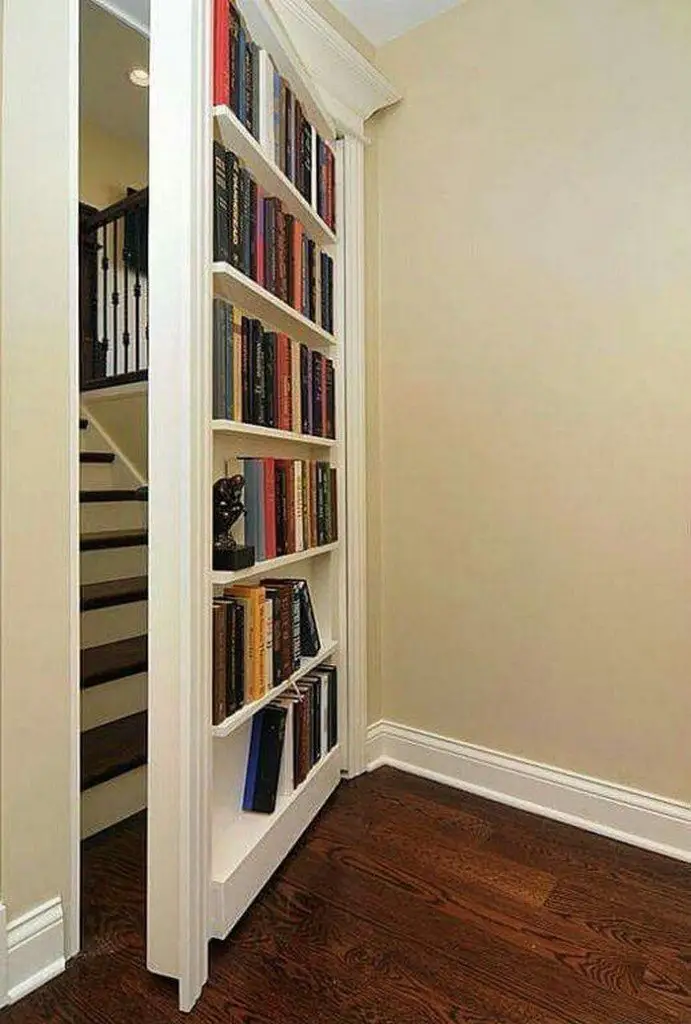

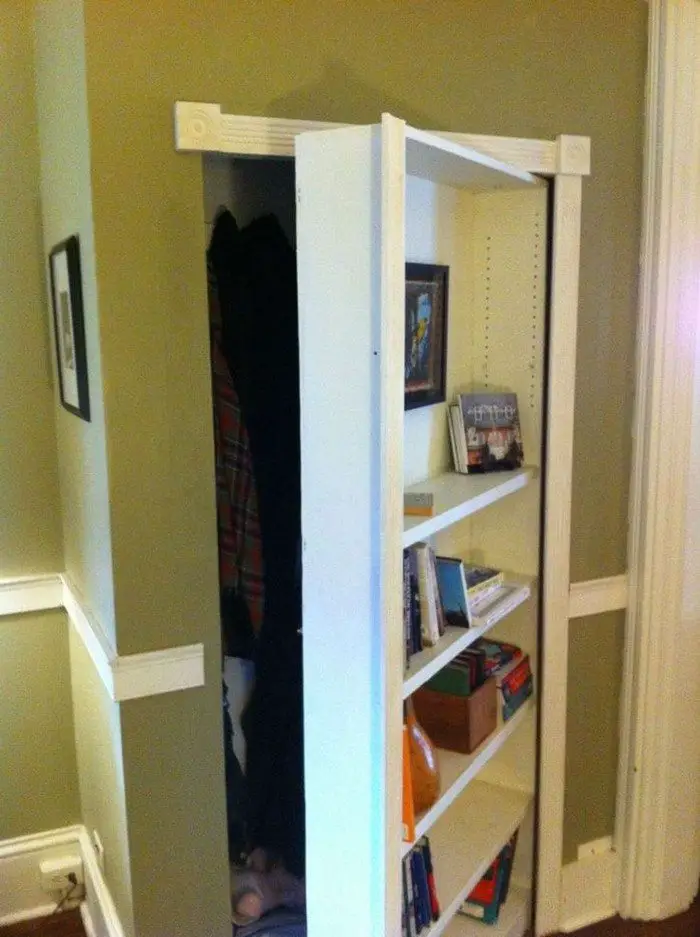
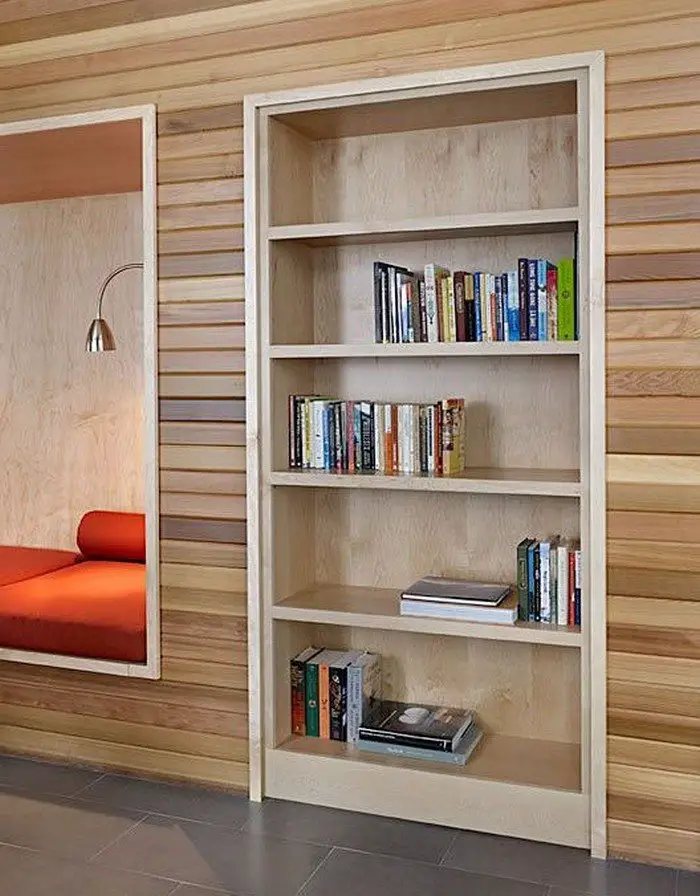
Space Optimization Techniques
Maximizing space in your home enhances its appearance and improves functionality. In small living areas, every inch counts, and finding innovative ways to use space can make a significant difference. One creative solution is transforming a door into shelves. This technique adds unique character to your home and offers additional storage without compromising floor space.
Below, we explore various space optimization techniques that leverage the door-into-shelves concept, providing aesthetic appeal and practical utility.
Choose Multifunctional Furniture
Incorporating multifunctional furniture into your home, like transforming a door into shelves, epitomizes smart space optimization. This innovative approach serves multiple purposes: it seamlessly functions as an entryway or a room divider when closed and transitions into a versatile storage or display unit when open.
The beauty of a door into shelves lies in its ability to blend aesthetic appeal with functionality, dramatically reducing clutter and freeing up much-needed space. By selecting furniture that fulfills more than one role, you not only enhance the efficiency of your living area but also create a more open, breathable space.
The door into shelves concept is a testament to how clever design can solve common space dilemmas, making it an ideal solution for those looking to maximize their home’s potential.
Utilize Vertical Space
Too often, the vertical spaces in our homes are overlooked, yet they hold immense potential for enhancing storage and organization. Transforming a door into shelves is a prime example of making the most out of vertical space. This strategy offers a plethora of storage opportunities for a wide array of items, from books and decorative pieces to essential household goods, without encroaching on valuable floor space.
Particularly in small living quarters, such as apartments or compact rooms, where managing space is crucial, a door into shelves can be a game-changer. It helps maintain a tidy and well-organized space and contributes to the room’s overall aesthetic.
Embracing vertical space by converting a door into shelves signifies a move towards smarter, more space-conscious living environments. This method proves especially beneficial, ensuring that every inch of available space is put to good use, fostering a cleaner, more structured, and harmonious home.
Implement Hidden Storage Solutions
Turning a door into shelves is an ingenious way to introduce hidden storage solutions into your home. This concept effectively utilizes a traditional door’s space, transforming it into a secret storage area that blends seamlessly with the room’s decor.
The door into shelves approach is a clever twist on conventional storage, hiding the storage function behind or within what appears to be a regular door. This technique can be replicated in various parts of the house, such as converting under-stair areas into discreet storage spaces, installing built-in wall cabinets that meld into the wall, or selecting furniture with hidden compartments.
Hidden storage solutions, like a door into shelves, play a critical role in maintaining a sleek and uncluttered look in your living spaces. They provide essential storage space without the visual clutter associated with traditional storage units.
This strategy is particularly effective in maintaining the aesthetic integrity of your home while maximizing functionality. A door into shelves not only offers a practical storage solution but also adds a layer of intrigue and sophistication to your interior design, proving that efficiency and style can coexist harmoniously.
Adopt a Minimalist Approach
Incorporating a minimalist approach in your home, including transforming a door into shelves, is a powerful strategy for space optimization. This method goes beyond merely adding storage options; it encourages a thoughtful reconsideration of what items are truly essential.
By converting a door into shelves, you effectively reduce clutter by repurposing the existing space, eliminating the need for additional furniture that can crowd the room. This approach emphasizes simplicity and functionality, encouraging a lifestyle that values quality over quantity.
A minimalist design, supported by the door into shelves concept, not only liberates physical space but also contributes to a more tranquil and spacious living environment. It fosters a sense of calm and order, making your home more inviting and comfortable.
The door into shelves acts as a symbolic and practical embodiment of minimalism, showcasing how innovative design can lead to a more organized and aesthetically pleasing space. By embracing minimalism, including the strategic use of a door into shelves, you create a home that is not only efficient and tidy but also a serene retreat from the chaos of the outside world.
Organize Efficiently
The transformation of a door into shelves brings about a unique opportunity to revamp your organizational strategy, making effective organization a pivotal aspect of maximizing its utility. By systematically grouping items based on their use, size, or color on your door into shelves, you can forge an organized and aesthetically pleasing display.
This method enhances the accessibility and functionality of the space, turning the door into shelves into a focal point of organization and style. Incorporating baskets or boxes within the shelves to further optimize this storage solution can neatly contain smaller items, effectively minimizing visual clutter.
The organization approach leverages the versatility of a door into shelves, ensuring every section of the newly created shelving space is utilized to its fullest potential. Organizing efficiently transcends mere placement of items; it transforms the door into shelves into a meticulously curated space that reflects both personal style and organizational savvy.
Embrace Adjustable Shelving
The incorporation of adjustable shelving into your door into shelves project introduces an unparalleled level of flexibility and customization to your storage solutions. This feature is instrumental in accommodating items of diverse sizes, from bulky textbooks to slender decorative pieces, ensuring that the door into shelves adapts to your storage needs rather than the other way around.
The beauty of adjustable shelving within the door into shelves concept lies in its ability to evolve with your changing needs, whether you’re adjusting to new hobbies, growing book collections, or shifting decorative themes. This adaptability ensures that every inch of your door into shelves is always in use, optimizing storage capacity and maintaining organization.
Embracing adjustable shelving in your door into shelves not only maximizes the space available but also supports a dynamic and ever-changing living environment. This level of customization enhances the door into shelves’ functionality, making it a versatile and indispensable addition to any space.
Incorporate Lighting
Incorporating lighting into your door into shelves transformation can elevate the unit from mere storage to a striking showcase within your home. Effective lighting not only illuminates the items you choose to display but also contributes to the ambiance of the room, enhancing its aesthetic appeal.
This can be particularly impactful in spaces that lack natural light or in areas of the home where you wish to create a specific mood. Installing LED strip lights underneath each shelf, or placing small, wireless LED lights strategically among your displayed items, can highlight your possessions and draw attention to the unique design of a door turned into shelves.
Such lighting solutions not only serve a functional purpose by making it easier to find and appreciate your items but also add a decorative element that can transform the overall feel of a space. The integration of lighting into your door into shelves project underscores the blend of functionality and design, turning everyday storage into an artful display.
Leverage Door Space
When converting a door into shelves, the door itself offers untapped potential that can significantly enhance the utility and efficiency of your storage solution. Utilizing the inside of the door for additional storage features, such as hooks or shallow baskets, can maximize the space that your door into shelves provides.
This approach is perfect for organizing smaller items that benefit from easy access, such as jewelry, scarves, keys, or even small tools and gadgets. By leveraging the door space in this way, you effectively expand the storage capabilities of your door into shelves unit, making it a multifaceted storage solution that caters to a variety of needs.
Making the most out of your door size optimizes the available space. It keeps essential items neatly organized and within reach, showcasing the versatility and ingenuity of integrating storage solutions into existing structures within the home.
Through thoughtful design and strategic use of all available surfaces, a door into shelves project can dramatically increase storage options, demonstrating that with creativity, even the most ordinary elements can be transformed into extraordinary storage solutions.
Optimizing space through innovative solutions like transforming a door into shelves can significantly enhance the functionality and appearance of your home. Adopting these space optimization techniques creates an organized, clutter-free environment that maximizes utility without sacrificing style.
Conclusion
Converting a door into shelves is an inventive and practical solution for adding unique storage and display space to any room. This project not only repurposes an existing material but also enhances your living space’s functionality and aesthetic appeal. Ensuring safety and stability throughout the process guarantees that this creative endeavor results in a durable and attractive addition to your home.
If you liked this, you will also like the DIY Hidden Bookcase Door Tutorial.





